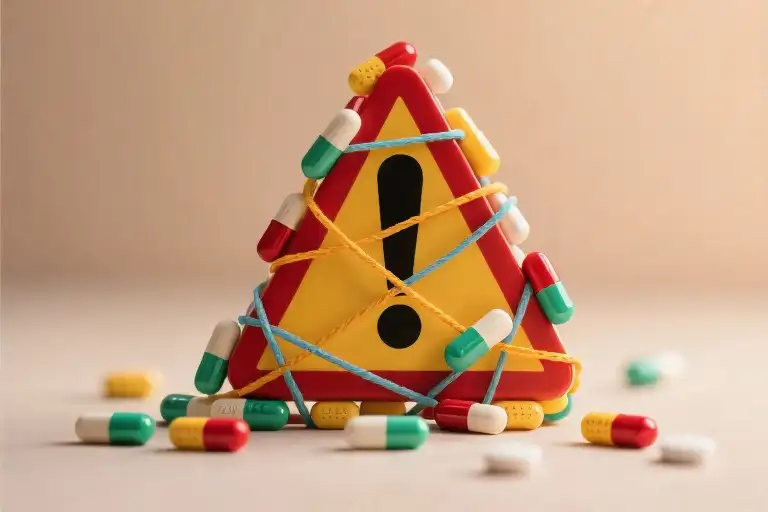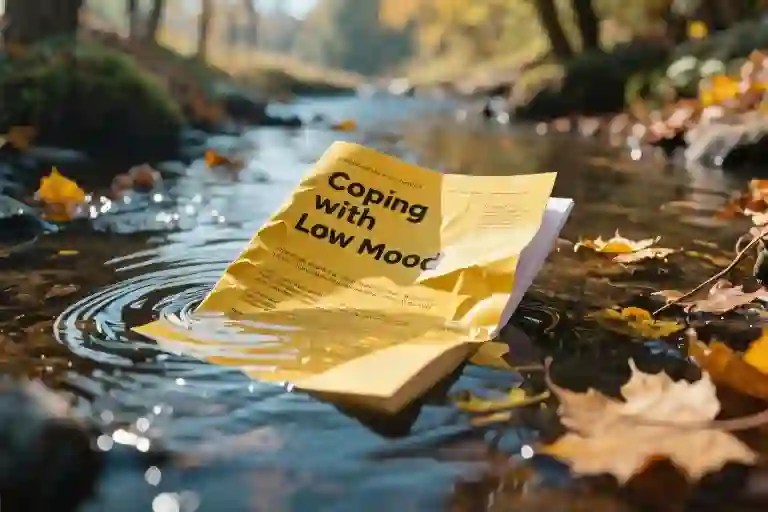The moment my new internist’s finger paused over my medication list, I felt that familiar twist in my stomach. Most doctors glance at my psychiatric prescriptions with polite disinterest—a quick check of lithium levels, maybe a perfunctory question about side effects. But this doctor was different. His eyes tracked each line like a detective reviewing crime scene photos, his frown deepening as he reached for his phone.
‘Is there an interaction between lithium and resistant inflammation?’ he murmured to a medical app I didn’t recognize. The fluorescent lights hummed overhead as I gripped the crinkling paper covering the exam table. After what felt like minutes, he looked up with startling directness: ‘Your psych meds are a mess. I wouldn’t be surprised if some of them are compromising your recovery from that persistent virus.’
My throat tightened. ‘I’ve recovered before on these same medications,’ I protested automatically, that knee-jerk defensiveness every chronic patient knows. These pills were my lifeline, my chemical scaffolding. The idea of tampering with them felt like threatening to remove load-bearing walls from a shaky house.
‘One variable has changed,’ he said, tapping my chart with his pen. ‘Something happening in a few weeks that your body’s already preparing for.’ His phone screen lit up with colorful interaction alerts as I stared, suddenly aware of how little I truly understood about the silent battles raging between my morning and evening pills. The sterile smell of antiseptic filled the room as he turned the screen toward me, revealing a web of red warning symbols I’d never seen before—not in fifteen years of medication management.
The Doctor Who Broke the Script
The clipboard made its usual journey across the desk, its metal clip catching the fluorescent light as it slid toward me. Another medication form, another ritual of listing the familiar alphabet of my psychiatric prescriptions. Over the years, I’d developed muscle memory for this dance – scribble the names, note the dosages, brace for the inevitable lithium level question. Most doctors’ eyes would glaze after the third medication, their pens already moving toward the next checkbox.
But Dr. Kessler’s fingers stopped moving when he reached page two of my medication list. His eyebrows did something unprecedented – they formed actual angles. For twelve years across seven psychiatrists, I’d only ever received variations on polite nods during this ritual. Now I was witnessing a medical professional frowning at my pharmaceutical history like it was a suspicious subway sandwich.
“Let me understand this,” he said, thumb hovering over his phone screen. “You’ve been on this SSRI since the Bush administration?” The glow from his drug interaction app reflected in his glasses as he muttered to himself, “lithium and NSAIDs… no, that’s not the concerning one…”
My palms stuck to the examination table paper. This wasn’t how the script went. Where was the perfunctory “When was your last blood draw?” Where was the reassuring pat about therapeutic levels? Instead, this stranger was conducting a full forensic audit of my brain chemistry.
“Your psych meds,” he announced, locking his phone with a decisive click, “are having a bar fight in your liver. And I’d bet my stethoscope some of these are holding the door open for that persistent virus.”
Every muscle in my body prepared to defend my chemical crutches. “But I’ve recovered from this before! Same meds, same me!” The protest came out shriller than intended. Those little pills weren’t just treatments – they were the shaky foundation of my functional adulthood. The idea of rearranging them felt like someone suggesting we remodel my skeleton.
Dr. Kessler flipped a page in my chart, his finger landing on some notation I couldn’t decipher. “One variable changed,” he said. “Something happening in about three weeks that your body’s already reacting to.”
The paper beneath me crackled as I shifted. What could possibly be significant about three weeks from now? My birthday wasn’t until winter, work projects were stable, even my apartment lease renewed in –
His chart-rustling interrupted my mental calendar check. “Tell me,” he asked in a tone that suggested he already knew the answer, “when was the last time anyone reviewed all these together?”
The silence stretched long enough to become its own diagnosis.
The Secret Battles in Your Pillbox
The moment my new internist frowned at my medication list, I realized something most patients never consider: our drugs don’t just work on us – they work on each other. That crumpled sheet of psychiatric medications I’d been handing to doctors for years wasn’t simply a treatment record; it was a battlefield map where lithium, antidepressants, and mood stabilizers engaged in constant chemical warfare.
How Medications Compete in Your Body
Imagine your liver as a busy airport with limited runways. Each psychiatric medication requires specific metabolic pathways – like planes needing clearance to land. When multiple drugs queue up for the same pathway (as many psych meds do), they create pharmacological gridlock. My doctor showed me his app’s alert: three of my medications were competing for the CYP2D6 enzyme system, potentially causing my lithium levels to fluctuate unpredictably.
‘This isn’t just about side effects,’ he explained, tapping the interaction warnings. ‘When drugs fight for metabolic real estate, they can either become less effective or dangerously concentrated. Your body spends so much energy managing this traffic jam, it has fewer resources to fight infections.’
The Fatigue That Wasn’t Depression
For years, I’d attributed my persistent exhaustion to depression – the very condition my medications were supposed to treat. The revelation that drug interactions might be causing or exacerbating my fatigue was unsettling. Research suggests up to 30% of patients on multiple psych meds experience similar ‘treatment-resistant’ symptoms that may actually stem from unrecognized pharmacological conflicts.
My doctor pointed to emerging studies showing how certain medication combinations can:
- Deplete essential nutrients like coenzyme Q10 and magnesium
- Overwork detoxification pathways, leading to inflammatory responses
- Alter gut microbiota in ways that impact immune function
When Helpers Become Saboteurs
The cruel irony? Medications prescribed to improve my mental health might have been undermining my physical recovery. This phenomenon, called ‘therapeutic competition,’ occurs when drugs prescribed for different conditions work at cross-purposes. In my case, an SSRI increasing serotonin levels could theoretically interfere with my immune system’s ability to regulate inflammation – potentially explaining why that stubborn virus kept coming back.
Signs Your Meds Might Be Fighting
Watch for these red flags that your medications may be in conflict:
- New or worsening symptoms after adding/changing medications
- Lab results that fluctuate unpredictably
- Needing frequent dosage adjustments for stable conditions
- Developing unusual sensitivities to foods or environmental factors
What You Can Do Today
- Use free tools like the NIH’s Liverpool Drug Interaction Checker to screen your current medications
- Request a ‘pharmacokinetic review’ at your next appointment – this analyzes how your drugs metabolize
- Keep a symptom log noting any changes after taking specific medication combinations
My doctor’s parting advice stuck with me: ‘Medications are tools, not solutions. We need to regularly check if your tools are still working together, or if they’ve started working against you.’ That prescription pad in his pocket? Turns out the most important treatment might be what he chose to subtract, not add.
Taking Charge of Your Medication Regimen
The moment my new internist declared my psychiatric medications “a mess,” I felt that familiar surge of defensive panic. For years, I’d operated under an unspoken contract with my healthcare providers: I’d dutifully swallow the pills, they’d refrain from questioning the regimen. This doctor shattered that arrangement with one blunt assessment.
Building Your Personal Medication Profile
Creating a comprehensive medication record proved more revealing than I anticipated. Start with these essentials:
- Current Medications List
- Include every prescribed drug, OTC medication, and supplement
- Note dosage, frequency, and prescribing doctor
- Record start dates (you’ll be shocked how long some have been in rotation)
- Treatment Timeline
- Map medication changes against life events and symptom fluctuations
- My chart revealed three antidepressants added during stressful periods, none ever discontinued
- Side Effect Log
- Track physical and cognitive changes after dosage adjustments
- I discovered my chronic fatigue began two months after adding a mood stabilizer
Navigating the Medication Conversation
When facing potential medication changes, these approaches helped me move from defensive to collaborative:
The Bridge Technique
“I understand your concern about drug interactions, and I worry about destabilizing my mood. Could we explore gradual adjustments with monitoring?”
The Data Request
“What specific risks does this combination pose? Are there studies showing alternatives with better outcomes for patients like me?”
The Trial Framework
“If we modify this prescription, what measurable changes should we track? How will we define success or need to revert?”
Digital Tools for Medication Management
After testing twelve apps, these stood out for medication reconciliation:
Medisafe
- Pros: Excellent interaction checker with severity ratings
- Cons: Clunky interface for complex regimens
- Best for: Visual learners who benefit from pill icons and reminder sounds
Drugs.com
- Pros: Most comprehensive database including supplements
- Cons: Less intuitive tracking of personal medication history
- Best for: Research-focused users who want detailed professional resources
MyTherapy
- Pros: Elegant symptom tracking integration
- Cons: Limited free version functionality
- Best for: Those monitoring multiple health metrics alongside medications
A surprising lesson emerged through this process: my medication list had become a static artifact rather than an evolving treatment plan. The act of creating my own profile – separate from any doctor’s records – shifted my perspective from passive recipient to active participant in my care. That yellowing prescription slip in my wallet didn’t define my treatment options; my ongoing observations and these new tools did.
The Digital Revolution in White Coat Pockets
The stethoscope around my new doctor’s neck wasn’t what caught my attention – it was the smartphone in his hand. As he frowned at my medication list, his thumb moved with practiced ease across the screen of a clinical decision support app. This scene, increasingly common in exam rooms nationwide, represents a quiet transformation in how medicine gets practiced.
Over the past three years, adoption of these digital tools has spiked dramatically. Recent data from the American Medical Association shows 72% of physicians now regularly use clinical decision support software, up from just 41% in 2019. The curve isn’t just rising – it’s accelerating. What began as simple drug interaction checkers have evolved into sophisticated diagnostic partners that analyze lab trends, flag unusual patterns, and even suggest alternative treatment pathways.
“These apps aren’t replacing clinical judgment,” explains Dr. Sarah Chen, an internist at Massachusetts General Hospital who researches digital health tools. “They’re like having a second pair of eyes that never get tired. Last month, one alerted me to a dangerous potassium-sparing diuretic combination that had slipped past three specialists.”
But this technological shift brings new complexities. The same study revealing widespread adoption also found concerning gaps – only 28% of doctors systematically verify app recommendations against current guidelines. There’s growing recognition of ‘alert fatigue,’ where clinicians start ignoring safety warnings after being bombarded with excessive or trivial notifications.
Perhaps most crucially, these tools change the therapeutic dynamic. My doctor’s app facilitated what traditional medicine often struggles with – making polypharmacy risks visible and discussable. When he rotated his screen to show me the interaction diagram, we stopped being adversaries debating medication changes and became collaborators interpreting data together.
Yet for all their benefits, these technologies have limitations no app store disclaimer will mention. They can’t detect how a patient’s hands tremble when describing side effects. They won’t notice the hesitation before answering “are you taking everything as prescribed?” And they certainly can’t replace what happened next in my appointment – when the doctor set down his phone, leaned forward, and asked about changes in my life that no algorithm would consider relevant to medication safety.
The revolution isn’t about replacing the physician’s brain with a database. It’s about using technology to create space for the human conversations that matter most. As I left the office that day, prescription changes in hand, I realized my doctor’s most valuable tool wasn’t the app itself – but his willingness to use it as a starting point rather than an endpoint.
This digital transition raises pressing questions we’re only beginning to confront: How do we maintain therapeutic relationships when screens mediate so many clinical interactions? What happens when patients arrive armed with app-generated second opinions? And crucially – who’s responsible when algorithm-driven care goes wrong? The answers will shape not just individual treatment decisions, but the future ethos of medical practice.
The moment my new internist’s finger paused over my medication list, I felt that familiar prickle of defensiveness creep up my neck. Most doctors glance at my psychiatric prescriptions with polite disinterest—a quick check of lithium levels, maybe a perfunctory question about side effects. But this physician actually frowned at the page, his thumb hovering above his phone screen where a drug interaction app lay open.
‘Your psych meds are a mess,’ he said finally, in that blunt tone I’d come to recognize as his trademark. The words landed like stones in my stomach. ‘Wouldn’t be surprised if some are compromising your recovery from that persistent virus.’
I opened my mouth to protest—of course I did. These medications were my scaffolding, the chemical architecture that kept me functional. ‘I’ve recovered before on this same regimen,’ I heard myself say, too quickly.
‘One variable’s different this time.’ His finger tapped a line in my chart I couldn’t see. ‘Something happening in a few weeks that changes the equation.’ The way his voice dropped made my pulse hitch. He turned a page, then another, his eyebrows knitting together in a way that suggested he’d stumbled upon a medical version of a plot twist.
We leave the scene there—doctor mid-discovery, patient mid-revelation—because this is where real medicine often lives. Not in tidy resolutions, but in those charged moments when a clinician’s intuition collides with established protocols. What makes this interaction remarkable isn’t the unresolved ending (though I’ll explore that ‘something happening’ in future writing), but the simple fact it happened at all. Most patients never get this level of engagement from their healthcare providers.
Consider your own last medication review. Did your doctor cross-reference each drug against current inflammation markers? Mine hadn’t—not until this appointment. The difference between routine care and exceptional care often comes down to willingness to sit with discomfort, both the physician’s and the patient’s. My instinctive resistance to his assessment? Perfectly normal. His refusal to soften his clinical observations because of that discomfort? Professionally courageous.
This dynamic—the push-pull between patient attachment to familiar treatments and doctor responsibility to challenge them—forms medicine’s most fertile ground for breakthroughs. Not all such conversations end well (some relationships can’t withstand this level of honesty), but when they do, they create space for what’s known in clinical circles as ‘deprescribing’—the deliberate reduction or elimination of medications that may be causing more harm than good.
What stays with me isn’t the unresolved question about my upcoming health variable (though that’s certainly preoccupying), but the model this interaction presents. Notice the components: technological aid (the interaction-checking app), clinical expertise (his ability to synthesize disparate health factors), and most crucially, the willingness to speak uncomfortable truths. It’s this triad—tool, training, and temperament—that transforms routine care into personalized medicine.
Your turn now. Pull out your own medication list—yes, right now—and ask what questions aren’t being asked about it. Not because your regimen is necessarily problematic, but because this level of scrutiny should be standard rather than exceptional. The best healthcare doesn’t always come in comforting packages; sometimes it arrives as a frown, a paused finger, and those four blunt words: ‘Your meds are a mess.





